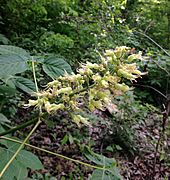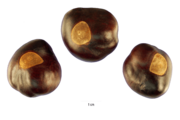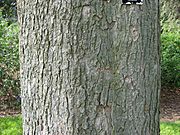Ohio buckeye facts for kids
Quick facts for kids Ohio buckeye |
|
|---|---|
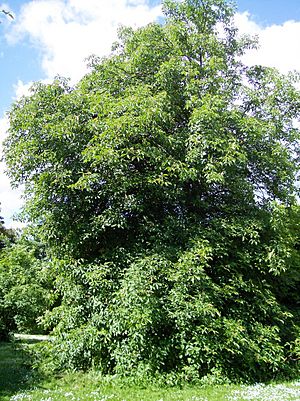 |
|
| Conservation status | |
| Scientific classification | |
| Genus: |
Aesculus
|
| Species: |
glabra
|
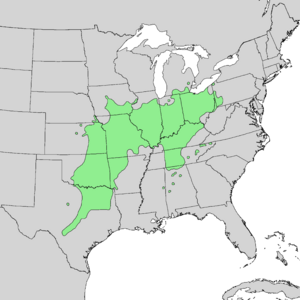 |
|
| Generalized natural range | |
The Ohio buckeye (scientific name: Aesculus glabra) is a type of tree that grows naturally in North America. It belongs to the soapberry family, known as Sapindaceae.
You can mostly find this tree in the Midwestern and lower Great Plains areas of the United States. It also grows southeast into parts of Alabama and Mississippi. You might even spot it in the very southwest of Ontario, Canada, especially on Walpole Island near Lake St. Clair.
Ohio buckeye trees like to grow in different natural places. They are often found along streambanks, in moist forests, and at the edges of old fields. They especially like areas where the soil has a lot of calcium.
Contents
What Does the Ohio Buckeye Tree Look Like?
The leaves of the Ohio buckeye tree are special. They are shaped like a hand with five separate leaflets, each about 8 to 16 centimeters (3 to 6 inches) long and wide.
In the spring, the tree grows beautiful flowers in clusters called panicles. These flowers can be red, yellow, or yellow-green. Each flower is about 2 to 3 centimeters (about 1 inch) long. The stamens (the parts that hold pollen) are longer than the petals. This is different from its relative, the yellow buckeye, where the stamens are shorter.
The fruit of the Ohio buckeye is a round capsule, about 4 to 5 centimeters (1.5 to 2 inches) across. Inside, it holds one nut-like seed. This seed is about 2 to 3 centimeters (about 1 inch) wide, brown, and has a whitish spot at its base.
It's important to know that the seeds of the Ohio buckeye are not safe to eat. They contain a substance called tannic acid and are poisonous to both cattle and humans. The young leaves, new shoots, and bark are also a bit poisonous. However, some Native Americans reportedly ate buckeye fruit after boiling it to remove the tannin.
How People Use the Ohio Buckeye Tree
The wood of the Ohio buckeye tree is soft and light, so it's not often used for timber (lumber). You might see it planted in gardens, but it's not a popular tree for streets because it produces many fruits that can be messy.
Native American Uses for the Buckeye
Native American tribes, like the Lenape, had special uses for the buckeye nuts. They would carry the nuts in their pockets, believing it helped with rheumatism (joint pain). They also made a mixture from ground nuts and sweet oil or mutton fat to help with earaches. Another interesting use was grinding the nuts and using them to poison fish in streams, making them easier to catch.
Native Americans also prepared buckeye nuts by blanching them. This process helped them remove the tannic acid, which they then used to make leather. The nuts could also be dried. As they dried and were exposed to air, they would turn dark and hard. People would string these dried nuts into necklaces, similar to those made from kukui nuts in Hawaii.
The Ohio Buckeye in Culture
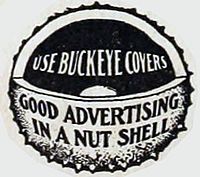
The Ohio buckeye is the official state tree of Ohio. The name "buckeye" was first used as a friendly nickname for the early settlers in Ohio. Later, "buckeye" became a common nickname for anyone from Ohio.
Ohio State University officially adopted "Buckeyes" as its nickname in 1950. Their sports teams are also called the Buckeyes. The name is now used for any student or graduate of the university.
There's even a popular candy called Buckeye candy. It looks just like the tree's nut! It's made by dipping a ball of peanut butter fudge into milk chocolate, but leaving a circle of the peanut butter showing. These candies are a favorite treat in Ohio, especially around Christmas and during the college football season.
Buckeye nuts also appear often in Bill Watterson's famous comic strip, Calvin and Hobbes. They are sometimes one of Calvin's tools for causing mischief. Bill Watterson himself grew up in Chagrin Falls, Ohio.
See also
 In Spanish: Falso castaño de Ohio para niños
In Spanish: Falso castaño de Ohio para niños




